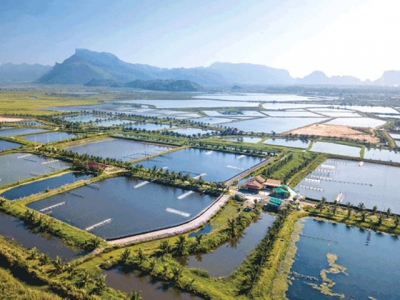Land Based Sustainable Aquaculture Strategy - Part 12

16/ Sludge management
Ponds should be dried regularly and de-silted. Removed silt/sludge can be used on-farm depending on the nature of the material. Sludge from tank aquaculture may be de-watered disposed of via:
- disposal to landfill;
- sent to a commercial composter; or
- used in agriculture.
17/ Managing other environmental issues
Noise
On farm noise sources such as those associated with construction, equipment for feeding,pumping, aeration, harvesting, maintenance and construction need to be managed, particularly if located near residential areas. Sound may travel at night due to the effects of temperature inversion, air drainage and winds. Consequently, the responsibility is on the operator of the farm to ensure that noise impacts do not unreasonably affect neighbouring residents not only during the day but also evenings or weekends. DECCW can provide information on the assessment and management of noise issues.
With all plant and equipment, every effort should be made to reduce the noise levels at the source, for example with fitted silencers, insulation, vegetated bund walls or maintenance programs. For farms needing a licence under the POEO Act, there is a requirement that all plant and equipment should be operated and maintained so as not to exceed the prescribed sound levels.
The use of noisy predator scare systems, sirens, PA systems, vehicle backing or other noisy devices that may be a noise nuisance should be minimised where possible.
Odour
Odour emissions from aquaculture facilities can be associated with drying ponds, storage of feeds and management of any dead stock or fish processing wastes.
Minimising impacts of odours should be considered in the farm layout (eg. feed storage area, equipment, waste, cleaning and maintenance depots) and during operational procedures (pond/tank dry-out procedures). Solid waste should be stored, transported and disposed of so as not to cause an odour nuisance.
Sediment from ponds or sludge from tanks must be disposed of in a manner that will minimise odour or leachate problems. Do not disturb sediments in ponds until dry, when it can be either incorporated into the bed of the pond or removed. Sediment from tanks should be stored in a designated storage area (within appropriate bunding or sediment trap to prevent sediment runoff to adjoining areas/waterways) prior to:
- spreading as top soil in appropriate crop or pasture areas; or
- transport to a commercial composter or landfill.
Dust
Dust can pose problems during construction stages and dry periods (see Planning and Design chapter). Appropriate surfacing of high volume traffic roads and vegetating wind exposed areas can minimise dust emissions. Until disturbed areas are stabilised, water and/or mulch should be used to control dust. It is recommended that neighbours be advised ahead of work schedules that are likely to generate dust.
18/ Visual appearance
Neat and tidy operations, vegetative screen plantings, earth mounds and aesthetically placed and coloured building should be adopted. In rural environments, landscaping should be used to soften the impact of ‘industrial’ shed complexes including planting of native species along boundaries.
Energy and greenhouse issues
Energy efficiency initiatives can lead to benefits which extend beyond energy savings to include pollution prevention, process efficiencies and increased productivity. Farm operations should be designed to minimise energy usage (eg. gravity distribution of water) and use renewable energy technologies (solar or wind power) where possible.
In addition, consider energy conservation and cost reduction opportunities including:
- monitoring annual and quarterly energy expenditure;
- maintain equipment performance;
- use of ‘off-peak’ energy;
- identifying and rectifying actions or activities that waste energy or use energy inefficiently.
Aquaculture operators may also be able to minimise their greenhouse gas emissions by participation in programs run by State and Federal Governments.
19/ Waste management
Waste management protocols should be developed to reduce and recycle waste and to store and dispose of waste material responsibly.
The POEO Act establishes a classification system for wastes, which is documented in the Environmental Guidelines: Assessment, Classification and Management of Liquid and NonLiquid Wastes (Waste Guidelines – EPA 1999). The obligations in respect of the management of wastes are based on their classification in accordance with the waste guidelines.
Environmental contingency planning
A Contingency Plan should be established with specified management actions documented to deal with problems should they occur. Issues that should be dealt with in the plan include:
- water quality incidents;
- predators;
- chemical spills;
- flooding;
- dam/pond security;
- power failure or mechanical failure of key equipment (especially important for tank
- aquaculture systems).
The Contingency Plan should include protocols which all staff should be made aware of including:
- agreed indicators that suggest that there is likely to be a problem;
- a requirement to alert appropriate senior person in the company immediately;
- what actions will be taken should the conditions deteriorate;
- what actions should be taken in the event that problem results in environmental breaches occurring;
- what actions should be taken in the event that the problem results in a loss of stock;
- when the regulatory authority and others should be alerted.
Other issues that may need to be contained in the Contingency Plan include drought proof planning in relation to pond/tank and/or potable water supplies particularly where water supply may not be reliable.
Có thể bạn quan tâm
 Land Based Sustainable Aquaculture Strategy - Part 9
Land Based Sustainable Aquaculture Strategy - Part 9 To determine the appropriate level of assessment for an aquaculture proposal, a test of significance and a project profile analysis can be referred
 Land Based Sustainable Aquaculture Strategy - Part 10
Land Based Sustainable Aquaculture Strategy - Part 10 Water quality management is more intensive in an RAS than pond aquaculture. RAS require sophisticated life-support equipment to maintain water quality
 Land Based Sustainable Aquaculture Strategy - Part 11
Land Based Sustainable Aquaculture Strategy - Part 11 Pond aquaculture should be monitored for water quality (DO, pH, temperature, TAN, ammonia)at least twice a week in summer